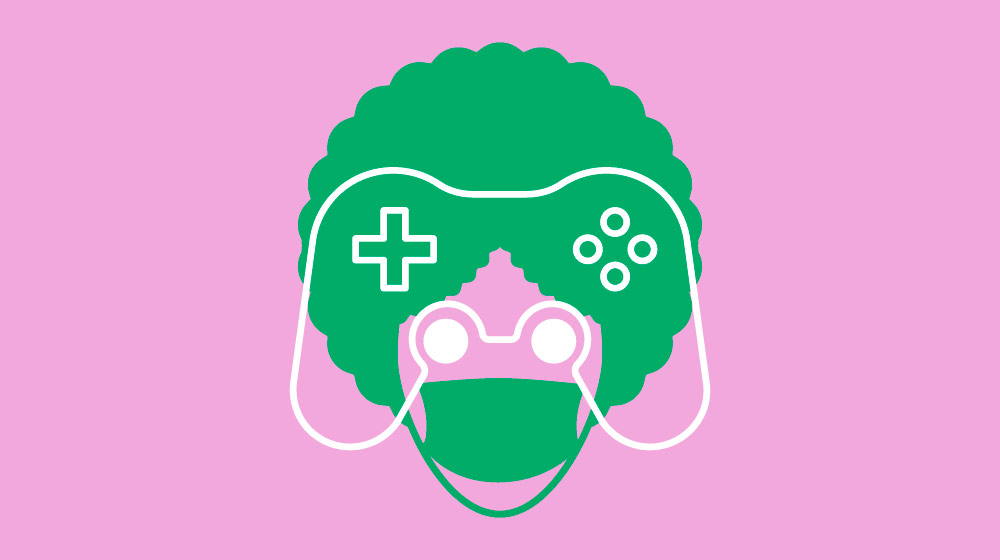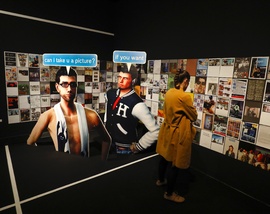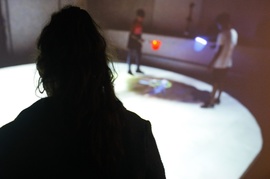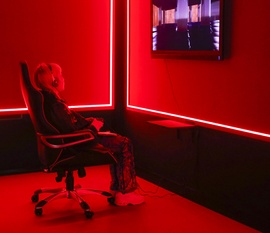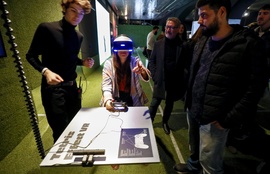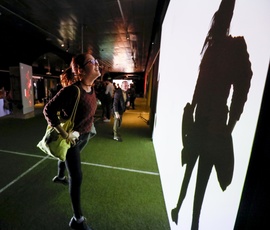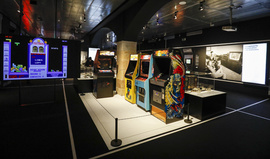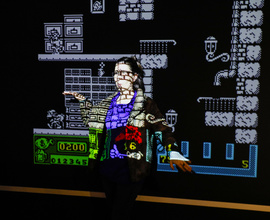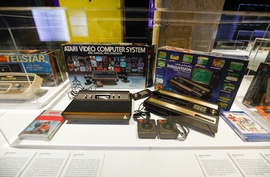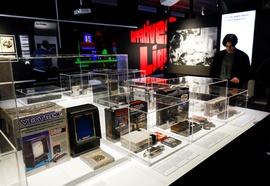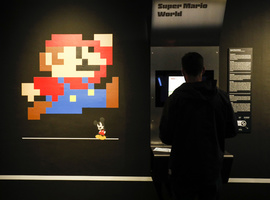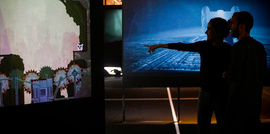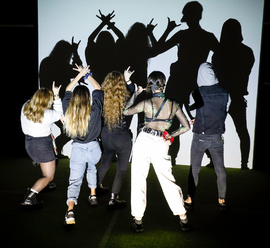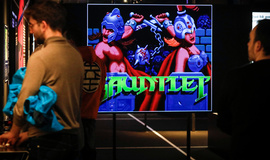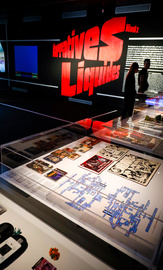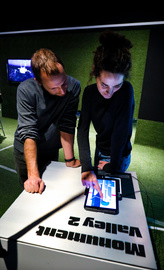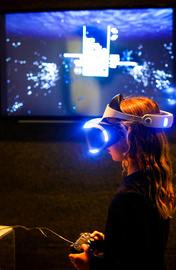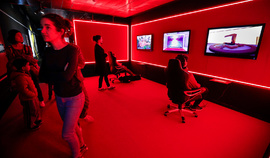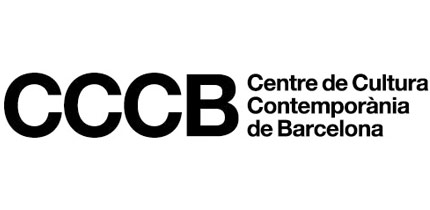Exhibition
Gameplay
Video Game Culture
"Gameplay" journeys to the origins of video games, analyses their language and highlights the impact they have had on popular digital culture and on art and society. The exhibition has been adapted to guarantee a safe experience.
The exhibition is designed as a space for reflection where visitors can (re)discover video game culture. "Gameplay" takes a look at the history of the medium, video game language, experimentation and artistic innovation, and critical and political video games. It includes more than forty audiovisual displays, documents, historical devices, recent indie-game creations, local research projects, and several installations by international artists: Mary Flanagan, Joan Leandre, Harun Farocki, Lawrence Lek, LaTurbo Avedon, Mónica Rikić and Blast Theory among others.
Since their popularisation in the seventies and eighties, video games have developed as an expressive and entertainment medium and now occupy a central space in our imaginary to the point that, today, it is impossible to understand contemporary society and culture without relating them with video gaming. The exhibition raises the issue of the increasing gamification of society: from mobile games to YouTubers, gamers and esports to so-called serious games, educational video games with applications that go beyond entertainment.
The new version of "Gameplay" in the halls of the CCCB wholly substitutes the interactives with new audiovisual contents.
"Gameplay" games available online
- Ambush. Developed by Tecfri | Published by Nippon Amuse |1983
- La pulga.Developed by Paco Suárez i Paco Portalo |Published by Indescomp / Investrónica | 1983
- September 12th. Developed by Gonzalo Frasca i Sof.a Battegazzore | Published by Powerful Robot Games| 2010
- Passage. Developed by Jason Rohrer | 2007
- Sísif (Let’s Play: Ancient Greek Punishment). Developed by Pippin Barr | 2011
- Limbo. Developed by Playdead | Publicació: Playdead | 2010 (demostración gratuíta)
- Crayon Physics Deluxe.Developed by Petri Purho | 2009
- Phone Story Developed by Paolo Pedercini |Published by Molleindustria | 2011
- DYS4IA. Developed by Anna Anthropy | 2012
- Unmanned. Developed by Molleindustria (Jim Munroe) | Published by Molleindustria | 2012
If you’re a fan of cinema and videogames, you shouldn’t miss the selection of films linked to videogame culture that can be viewed on the Gameplay channel on Filmin.
"Gameplay. Video Game Culture" is an extended adaptation of "Gameplay. The Next Level", designed by and first presented at the ZKM Center for Art and Media Karlsruhe.
Curators: Jérôme Nguyen, Óliver Pérez Latorre
LEVEL_1. REPLAY. THE ORIGINS OF VIDEO GAMES
Video games grew out of three technologies: computer games, coin-op machines (pay-toplay) and consoles. However, the history of the origins of video games is a history in which technological evolution is interwoven with social changes, the development of the early genres characteristic of the medium, and the emergence of new imaginaries for children and teenagers, in which Nintendo became a new Disney. This seminal period of video game culture (the 1970s and 80s) has traditionally been told from the angle of Japan and the USA, but pioneering creators and companies in Spain and Catalonia played an interesting role during this era that needs to be highlighted.
Links to some of the games in this section:
AMBUSH. Developed by: Tecfri | Published by: Nippon Amuse |1983
LA PULGA. Developed by: Paco Suárez and Paco Portalo | Published by: Indescomp / Investrónica | 1983
LEVEL_2 LIQUID NARRATIVES
The video game is a medium that is both narrative and playful, a medium for which creators can structure the design of the rules of play and the game mechanics (patterns of interaction), the non-linear narrative and the depiction of imaginary worlds in order to provide us with unique interactive experiences. At the same time, the language and culture of video games have always been closely linked to their connections with popular narratives and analogue games. Notwithstanding this, in the popular imaginary, video games are associated with the pleasure of deciding, a certain rethoric of decision-making characteristic of video game advertising: “[in video games] you are free, everything depends on you”.
Links to some of the games in this section:
SEPTEMBER 12TH. Developed by: Gonzalo Frasca and Sofía Battegazzore | Published by: Powerful Robot Games| 2010
PASSAGE. Developed by: Jason Rohrer | 2007
SÍSIF (LET’S PLAY: ANCIENT GREEK PUNISHMENT). Developed by: Pippin Barr | 2011
LEVEL_3. ART AND THE GAMING ESSAY
Innovation and aesthetic experimentation in the field of video games are a response to complex overlaps between art, technology and play. In recent years, a new generation of independent creators and indie game authors has been exploring game styles that are alternative or opposed to the mainstream or detached from it. Alongside this, some video games that have left their mark on the imaginary of the medium are based on relatively simple yet ground-breaking concepts of play thanks to technologies, interfaces and/or forms of interaction that seem to invite us to simply play for play’s sake but in a novel and riveting way.
Links to some of the games in this section:
LIMBO. Developed by: Playdead | Published by: Playdead | 2010 (free demo)
CRAYON PHYSICS DELUXE. Developed by: Petri Purho | 2009
LEVEL_4. BREAKING THE MAGIC CIRCLE
Historically, video games have been criticised for being an escapist medium, for being set in a magic circle that cuts us off from real life. Even so, they are exerting an increasingly powerful influence on the way many people perceive and interpret the world. This impact of video games on the social imaginary is not simple, nor is it only one-way: video games often reiterate dominant ideologies and reinforce gender stereotypes, but they can also communicate alternative discourses, feminist or green messages, and can convey critical thinking on a range of themes, including technological capitalism itself and the video game industry.
Links to some of the games in this section:
PHONE STORY. Developed by: Paolo Pedercini | Publicaci.: Molleindustria | 2011
DYS4IA. Developed by: Anna Anthropy | 2012
UNMANNED. Developed by: Molleindustria (Jim Munroe) | Published by: Molleindustria | 2012
LEVEL_5 LUDOPOLIS. GAMIFIED LIVES
Contemporary society has become videogamified. Video games have infiltrated people’s lives at different levels and in very different ambits: gamified design now permeates all kinds of social media, digital apps and even workplaces; and video games are increasingly used in education and vocational training. At the same time, the audience for video games has expanded and the uses and enjoyment of video games have become more diverse: mobile phone games, the YouTuber phenomenon and esports (video game competitions) are three key vectors for the rise of video games in entertainment today.
Related contents
Alessandro Baricco and Jorge Carrión
Augmented Humanity
In the present situation of health emergency and restrictions on collective life, the Italian novelist and essayist Alessandro Baricco, and the writer Jorge Carrión will speak from their respective confinements about this unprecedented state of affairs and its meaning and consequences at the global level.
Lucía Lijtmaer and Jordi Costa
Personal Genealogy of the Videogame
The writer Lucía Lijtmaer speaks with Jordi Costa, head of exhibitions at the CCCB, about the cultural and social references that have marked their personal relationship with videogames.
